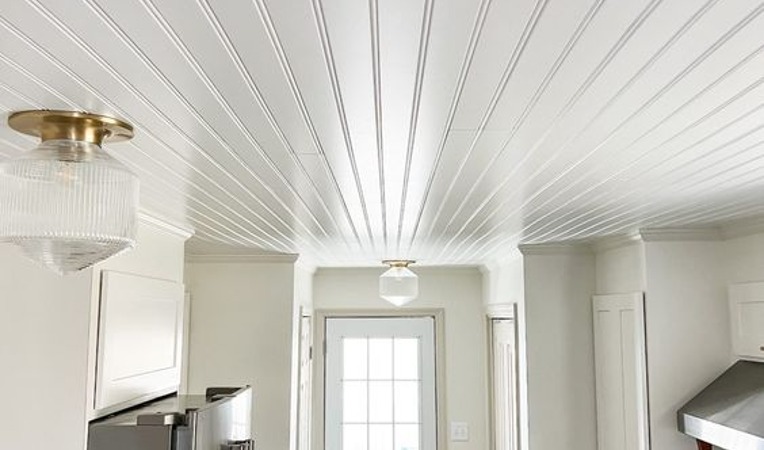Exposing the Hazards: Unveiling the Threat of Asbestos in Popcorn Ceilings! Concealed above, within numerous households nationwide, an inconspicuous peril lurks. Once a representation of modernity and elegance, the popcorn ceiling has now become a repository for a treacherous secret. Beneath its seemingly harmless, textured facade lies an undisclosed danger that may bring catastrophe to unsuspecting homeowners – asbestos. This deceitful mineral, once celebrated for its heat resistance and noise reduction properties, has been unveiled as a fatal carcinogen. Disturbing these popcorn ceilings can unleash asbestos fibers into the atmosphere. Imperceptible to the human eye, these fibers can be inhaled into the lungs where they remain dormant, silently inflicting havoc on one’s well-being.
The danger of asbestos lurking in Popcorn ceilings is a looming catastrophe that must not be disregarded. It is imperative to unveil this concealed peril and safeguard ourselves against the insidious threat of popcorn ceilings and asbestos exposure!
hat is Popcorn Ceiling Made Of?

Popcorn ceilings, also known as acoustic ceilings, have been a popular choice for homeowners since the mid-20th century. Their unique texture adds character and helps to hide imperfections. However, there has been growing concern about the materials used in popcorn ceilings, particularly in relation to asbestos. In this blog post, we will delve into the composition of popcorn ceilings, explore the potential presence of asbestos, and provide insight into the safety considerations for homeowners.
Examining the Formation of Popcorn Ceilings and Their Asbestos Content
Popcorn ceilings often consist of a blend of substances, such as drywall compound and texture additives, occasionally supplemented with paint. These texture additives are responsible for the unique look of popcorn ceilings. Among these additives, one may find materials like Styrofoam, vermiculite, or even asbestos fibers in older buildings.
Comprehending the Dangers of Asbestos in Popcorn Ceilings
Popcorn ceilings were once a popular choice in construction, often containing asbestos, a naturally occurring mineral known for its ability to withstand fire and last long. However, in the late 1970s, people started realizing the health hazards associated with asbestos inhalation, which can cause severe respiratory illnesses like lung cancer and mesothelioma.
The Disturbing Link Between Popcorn Ceilings and Asbestos
Homeowners have valid concerns about the possible existence of asbestos in older popcorn ceiling mixtures. If your house was built before the late 1970s, there is a greater chance of finding asbestos in the popcorn ceiling. Nevertheless, it is crucial to understand that not all Popcorn ceilings contain asbestos, and proper testing is necessary for confirmation.
Guaranteeing Security: Screening for Asbestos in Popcorn Ceilings
In order to ascertain whether your popcorn ceiling harbors asbestos, it is imperative to enlist the services of a certified expert in asbestos testing. These professionals will obtain samples from your ceiling and dispatch them to a laboratory for evaluation. It is highly recommended against attempting any do-it-yourself testing, as disturbing the ceiling without adequate precautions can result in the release of airborne asbestos fibers.
Possible Approaches to Addressing Popcorn Ceilings with Asbestos
If you discover that your popcorn ceiling contains asbestos, you have a few choices to explore. These include applying a specialized coating to contain the asbestos fibers or hiring a certified professional to remove it. Each option comes with its own factors to think about, expenses, and potential effects on your home.
Why is popcorn ceiling good?

Popcorn ceilings, once the reigning champions of interior design, are a sight to behold. These textured wonders bring a touch of nostalgia and soundproofing magic to any space they grace. But that’s not all! Beyond their visual appeal and acoustic benefits, these textured marvels also act as a reliable shield, concealing flaws with their rugged texture. However, hidden beneath this tough exterior lies a potential danger – asbestos. Widely utilized in popcorn ceilings from the 1950s to the 1980s, asbestos was valued for its fire-resistant qualities.
However, do not allow this to discourage you from embracing the allure of these textured gems! As long as undisturbed, asbestos presents minimal danger. So, why should we appreciate popcorn ceilings? It’s quite straightforward! Popcorn ceilings perfectly embody the fusion of functionality and individuality. They boast durability, excellent sound absorption capabilities, and an irresistibly retro-chic aesthetic. Let’s give a round of applause for popcorn ceilings – the underappreciated champions of home decor!
Why is it called popcorn ceiling?

Marvel at the mysterious allure of the popcorn ceiling, a nostalgic vestige from the mid-1900s that continues to embellish numerous households in modern times. Its captivating and peculiar name originates from its uncanny likeness to the cherished treat. Each minuscule and irregular protrusion mirrors the fluffy grains we relish at movie theaters, fashioning a visually captivating display that gracefully traverses your overhead space.
However, hidden behind the whimsical appearance lies a dark secret – asbestos. This dangerous substance was frequently utilized in popcorn ceilings until the late 1970s for its ability to resist fire and its long-lasting nature. Nevertheless, when disturbed, these asbestos fibers can become airborne and pose a significant health hazard if inhaled. Consequently, the popcorn ceiling, with its charming name and distinctive visual appeal, represents an intriguing mix of allure and peril – serving as both a testament to past design choices and a stark reminder of the concealed dangers they may contain.
Should I remove popcorn ceiling?

In the mid-20th century, Popcorn ceilings, also referred to as acoustic ceilings, gained immense popularity. Nevertheless, in recent times, homeowners have begun to question the desirability of these textured ceilings and whether they should be eliminated. This blog post will explore the advantages and disadvantages of popcorn ceilings, with a specific emphasis on the existence of asbestos, in order to assist you in making an informed choice.
The Appeal of Popcorn Ceilings
Originally, popcorn ceilings gained popularity for their capacity to conceal flaws and dampen sound in a space. The textured appearance introduced a distinct visual aspect to the ceiling, establishing a warm and sentimental atmosphere.
The Issue with Asbestos in Popcorn Ceilings
Popcorn ceilings can be a cause for concern due to the potential existence of asbestos. Asbestos was widely utilized in construction materials until the late 1970s, when its detrimental health effects became widely recognized. If your home was constructed prior to this era, there is a chance that your popcorn ceiling contains asbestos fibers, which can pose a danger if disturbed.
Dangers to Health
Popcorn ceilings containing asbestos typically do not present substantial health hazards as long as they remain intact and undisturbed. Nonetheless, any damage to the ceiling or intentions to renovate your home can potentially release asbestos fibers into the atmosphere. Inhalation of these fibers may result in severe health complications, including lung cancer and mesothelioma.
Removal Process
When dealing with Popcorn ceilings that may contain asbestos, it is crucial to adhere to appropriate safety measures. It is highly advised to enlist the services of a qualified asbestos abatement specialist who possesses the expertise, tools, and understanding required for the secure removal of the ceiling.
Alternatives to Removal
If you have concerns about removing your popcorn ceiling due to the presence of asbestos, there are alternative options to explore. One possibility is to cover it with a fresh layer of drywall, providing a new and improved appearance. Alternatively, you can consider techniques such as skim coating or decorative ceiling tiles to update the look without the necessity of complete removal.
Conclusion
Popcorn ceilings that contain asbestos pose a significant risk to the health and safety of individuals residing in affected homes. Asbestos exposure can lead to serious respiratory diseases and even cancer. Therefore, it is crucial for homeowners, renters, and buyers to be aware of the potential presence of asbestos in popcorn ceilings and take appropriate actions to mitigate the risks. This may include testing for asbestos, hiring professionals to remove or encapsulate the material, or considering alternative ceiling options altogether. By being proactive and knowledgeable about popcorn ceilings containing asbestos, we can ensure a healthier living environment for ourselves and our loved ones. Don’t wait until it’s too late – take action today!




